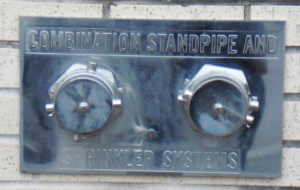Fire Department Connections on Large Sprinkler Systems

To understand when a sprinkler system fire department connection (FDC) needs to be supplemented vs supplied, we must first discuss the widely used term, system demand. This term is not defined in any of the fire sprinkler standards, but National Fire Protection Association (NFPA) 13 Standard for the Installation of Sprinkler Systems does require a system to have a hydraulically calculated water demand flow rate, and this term is defined by NFPA 13. The waterflow rate for a system must be calculated using acceptable engineering practices and is commonly referenced as the system demand.
3.3.109 Hydraulically Calculated Water Demand Flow Rate -The waterflow rate for a system or hose stream that has been calculated using accepted engineering practices
System Demand for Water-Based Fire Protection
 System demand is calculated on an area of a building, based on the occupancy and/or commodities stored within and does not include all areas of a building. If a fire advances beyond the fire protection system design area, it will eventually exceed the designed system flow or demand. This is a critical transition point when the fire department needs to convert from supplementing the system and will take over supplying the system beyond the hydraulically calculated water demand flow rate.
System demand is calculated on an area of a building, based on the occupancy and/or commodities stored within and does not include all areas of a building. If a fire advances beyond the fire protection system design area, it will eventually exceed the designed system flow or demand. This is a critical transition point when the fire department needs to convert from supplementing the system and will take over supplying the system beyond the hydraulically calculated water demand flow rate.
FDC Sizing for Fire Sprinkler Systems
While NFPA 13 requires fire sprinkler systems to have an FDC consisting of two 2 ½ in. inlets, it does not have any requirements for them to be sized for the hydraulically calculated water demand flow rate. The thought behind this is that the system water supply automatically provides the required system demand based on the design area and the FDC is only intended to supplement that required flow. In most cases the two 2 ½ in. inlets are more than capable of providing that supplemental flow. The question is what happens when the system design flow is exceeded, and the fire department moves from supplementing the system, to needing to supply the flow above the designed system demand? Transitioning from Supplementing to Supplying
Transitioning from Supplementing to Supplying for Fire Sprinkler Systems
While this transition is more prevalent in many of the recent mid-rise buildings fires constructed to NFPA 13R Standard for the Installation of sprinklers in Low-Rise Residential Occupancies, with systems designed for life safety occupant egress, we have also seen large scale fires involving mammoth distribution or processing buildings. These large facilities often have large system demands well exceeding the limitations of a two 2 ½ inch FDC inlet.
NFPA 14 Standard for the Installation of Standpipe and Hose Connection gives guidance on the sizing of fire department connections 2 ½ inlets in Section 7.12.3 and requires 250gpm for each inlet. This sizing has been in the standard for many years but only applies to standpipe or combine sprinkler standpipe systems.
7.12.3 Fire department connection sizes shall be based on the standpipe system demand and shall include one 21∕ 2 in. (65 mm) inlet per every 250 gpm.
Providing System Flow from an FDC
This concern is not an issue with combined systems, as the flow requirement needs to be in accordance with the greater flow and the FDC is sized accordingly, so that the system demand can be supplied by the FDC.
7.7.1 Class I and Class III standpipe systems shall be designed so that the system demand can be supplied by each fire department connection, which is provided in accordance with Section 7.12.
7.10.1.3.1.1 In a building protected in accordance with NFPA 13 or NFPA 13R, the water supply for the combined sprinkler and automatic standpipe system shall be based on the sprinkler system demand, Including any hose stream demand, or the standpipe demand, whichever is greater.
The issue is created when the NFPS 13 required two 2 ½ in. fire department connections on sprinkler only systems with large hydraulically calculated water demand flow rates is not capable of appropriately supplement the system.
Many of these large buildings have very robust automatic sprinkler systems often with calculated demand flows well above the capabilities of that two 2 ½ in inlets or 500gpm inlet standard.
While automatic sprinkler system are required and designed to provide an automatic water supply and an FDC to supplement the hydraulically calculated water demand flow rate, we now see the benefits of being able to fully supply additional flow rates from the FDC, that exceeds the design flow. It might just be time to discuss FDC sizing for larger sprinkler systems with larger designed flows.
From Fire Department Connections to Hydraulic Calculations, The NFSA is Your Premier Codes and Standards Resource
The National Fire Sprinkler Association (NFSA) is a premier resource for everything related to fire protection. Our expert team can help you our with any codes questions you may have with our EOD service.
For more information on membership, visit our join page!
